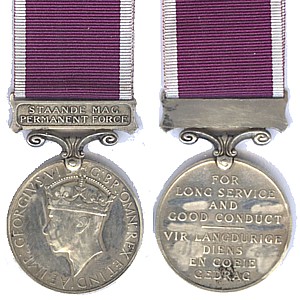Medal for Long Service and Good Conduct (South Africa) facts for kids
Quick facts for kids Medal for Long Service and Good Conduct (South Africa) |
|
|---|---|
 |
|
| Country | |
| Type | Military long service medal |
| Eligibility | Permanent Force Other Ranks, extended to Officers c. 1940 |
| Awarded for | 18 years service and good conduct |
| Status | Discontinued in 1952 |
| Statistics | |
| Established | 1939 |
| Order of wear | |
| Next (higher) | |
| Equivalent | |
| Next (lower) | |
Ribbon Bar |
|
The Medal for Long Service and Good Conduct (South Africa) was a special award given in South Africa. It was like a South African version of a British medal. This medal was given to members of the Union of South Africa's Permanent Force. They earned it by serving for eighteen years with good behavior.
Contents
History of the Medal
Early Medals for Long Service
The idea of giving medals for long service started a long time ago. In 1830, King William IV created the Army Long Service and Good Conduct Medal in the United Kingdom. Later, in 1895, Queen Victoria allowed different versions of this medal. These were for soldiers in the British Dominions and Colonies, like South Africa.
In 1910, King Edward VII introduced a new medal. It was called the Permanent Forces of the Empire Beyond the Seas Medal. This medal replaced the older versions for soldiers outside the UK.
Creating the South African Medal
On 23 September 1930, King George V decided to change how long service medals were given. He replaced the older medals with a new one. This new medal was called the Medal for Long Service and Good Conduct (Military).
This new medal was meant for soldiers in all the Permanent Forces. This included forces in the UK, Dominions, Colonies, and the Indian Army. To show where a soldier served, a special bar was added to the medal. This bar had the name of the country or force. For example, British Army medals had "Regular Army" on the bar.
The Medal for Long Service and Good Conduct (South Africa) was a bit different. It was introduced in December 1939. The words on its bar and on the back of the medal were in two languages: Afrikaans and English. The bar said "Staande Mag" and "Permanent Force".
Who Earned the Medal?
Award Rules
At first, this medal was only given to warrant officers and other ranks. These were soldiers who had completed eighteen years of good service in the Permanent Force.
During and after the Second World War, officers could also receive this medal. They needed to have served at least twelve of their eighteen years as lower ranks. Sometimes, time spent in war counted as double service.
Extra Awards for More Service
In 1940, a special Clasp was added for the medal. This Clasp was for soldiers who completed thirty years of service. An officer could get this clasp if they had served twenty-two or more of their thirty years as lower ranks.
How the Medal Was Worn
Order of Medals
Medals are worn in a specific order. The Medal for Long Service and Good Conduct (South Africa) was worn alongside the Medal for Long Service and Good Conduct (Military). It came after the Accumulated Campaign Service Medal. It was worn before the Naval Long Service and Good Conduct Medal (1830).
South African Order
From 6 April 1952, South Africa started using its own new medals. The older British medals, like this one, were still worn. However, they were worn after all the new South African medals. The only exception was the Victoria Cross, which always came first.
Here is how some of these medals were worn in South Africa:
- Preceded by the Permanent Forces of the Empire Beyond the Seas Medal.
- Succeeded by the Volunteer Officers' Decoration for India and the Colonies (VD).
What the Medal Looked Like
Front of the Medal
The medal was made of silver and was a round disk. It was about 36 millimeters wide. On the front, it showed a picture of King George VI. Around the edge, it said "GEORGIVS VI D: G: BR: OMN: REX ET INDIAE IMP:".
Back of the Medal
The back of the medal was plain. It had words in both English and Afrikaans. It said "FOR LONG SERVICE AND GOOD CONDUCT" and "VIR LANGDURIGE DIENS EN GOEIE GEDRAG". The name of the person who received the medal was carved into its edge.
The Bar and Ribbon
A bar was attached to the top of the medal. This bar had "STAANDE MAG" and "PERMANENT FORCE" written on it.
The ribbon for the medal was 32 millimeters wide. It was a deep red (crimson) color with white stripes on each side. Each white stripe was 3 millimeters wide.
When the Medal Stopped Being Awarded
The Medal for Long Service and Good Conduct (South Africa) stopped being awarded on 6 April 1952. It was replaced by a new medal called the Union Medal. The Union Medal could be given to both officers and other ranks. They also needed to complete eighteen years of good service in the Permanent Force.

